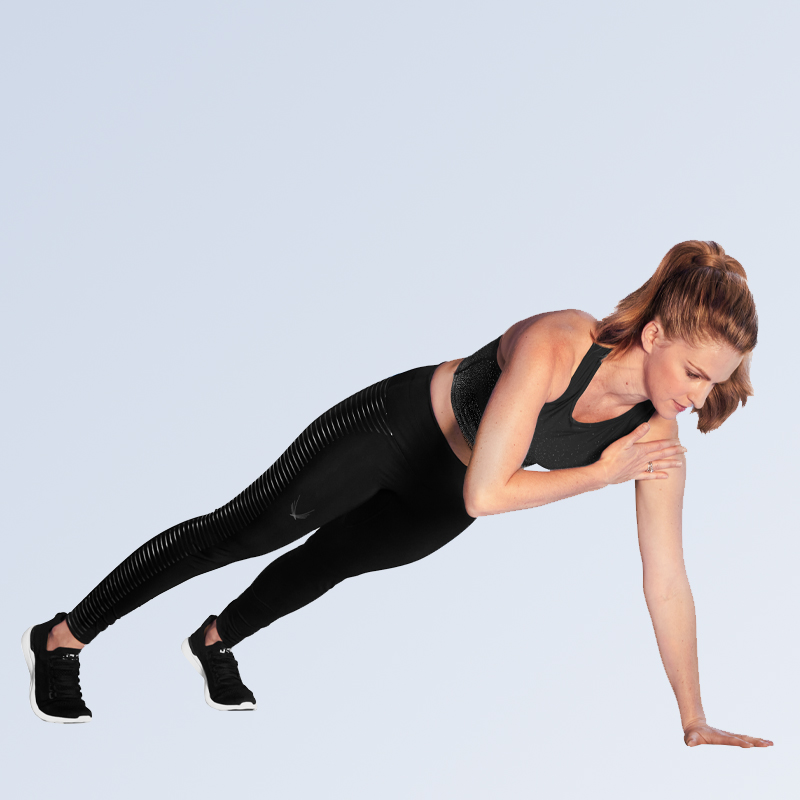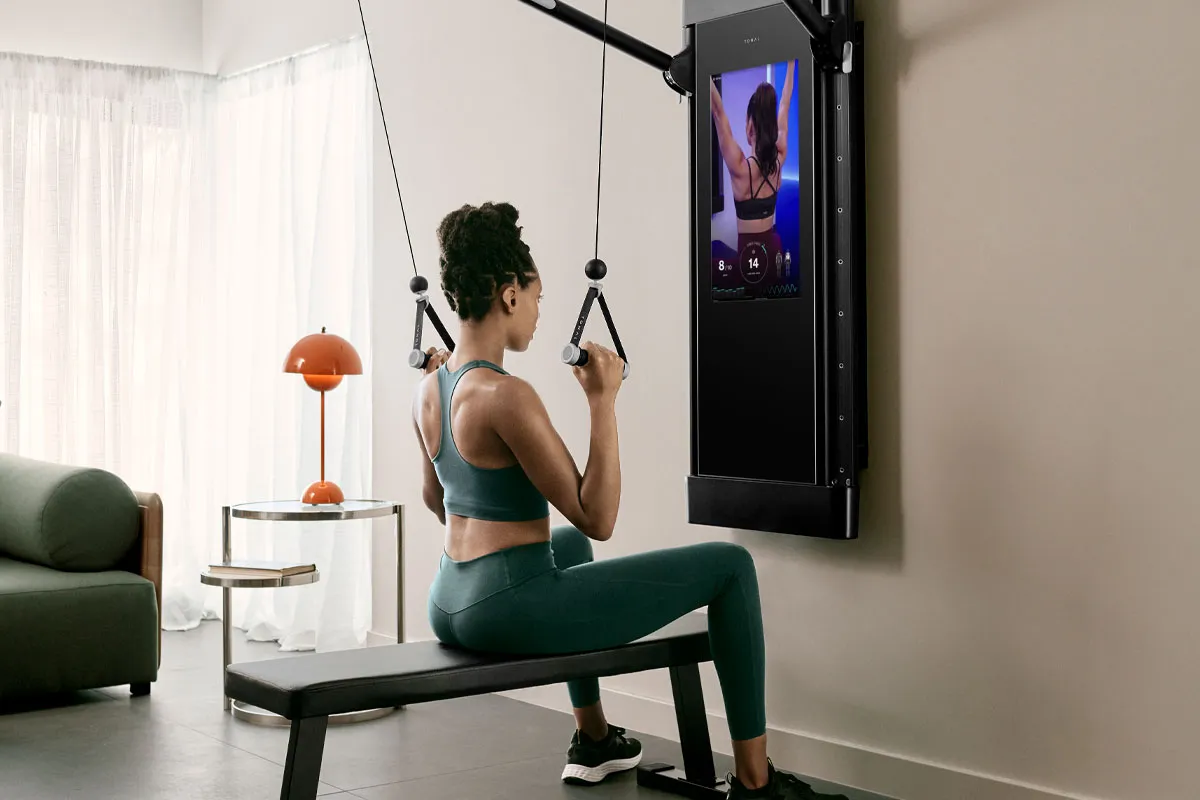Learn the primary causes of lower back pain and how you can get relief at home.

If you’re suffering from lower back pain, you’re not alone. According to one review of studies, 10 to 30 percent of U.S. adults suffer from back pain annually, and 65 to 80 percent will experience it over the course of their lives.
While there are many different causes of back pain, lower back in particular is often rooted in muscular weakness and core instability. Strengthening these muscles, even with simple at-home exercises, can often bring relief.
Read on to learn more about the best exercises for lower back pain and why using Tonal, with its personalized weight recommendations and form guidance, is one of the best ways to train to reduce lower back pain. If you’re currently in pain, it’s always best to check with your doctor or medical provider before starting any new exercise routine.
What Causes Lower Back Pain?
Even though lower back pain is common, the source of the discomfort can vary widely. Along with conditions that typically occur in older adults such as degenerative disk disease (which can cause a herniated disk) and osteoporosis, lower back pain may be the result of an acute or chronic strain in a muscle or tendon.
When a chronic condition or injury isn’t causing your pain, biomechanical issues like form and positioning may be to blame, says Tim Landicho, a certified personal trainer and Tonal coach.
“A lot of people live in an overextended position with an arch through the back, the ribcage flared, and an anterior [forward] pelvic tilt,” he says. In this position, the spinal erector muscles lining the vertebrae are consistently overstressed. Landicho adds that overtraining and taking on too much volume too soon can exacerbate lower back pain by adding load to an already overstressed system. That’s why he recommends Tonal, which offers guided programs that increase volume gradually so you won’t overtax your body. Tonal also gives consistent feedback on your form to reinforce good posture and alignment.
Strengthening and stabilizing the muscles and joints that support the back can help improve your posture and reduce the load on your spinal muscles. As Tonal coach and certified personal trainer Kristina Centenari explains, limited spinal mobility, lack of core strength and stability, and weak hip flexors, glutes, or hamstrings may all lead to lower back pain.
While conditions like degenerative disk disease and osteoporosis are best managed under the care of a doctor or physical therapist, there are at-home back back exercises you can try to address the mobility issues and muscle weaknesses that commonly cause pain.
Here are Centenari”s and Landicho’s picks for the best exercises to relieve lower back soreness.
Spinal Mobility Exercises for Lower Back Pain
To see if a lack of spinal mobility is the cause of your back pain, Centenari describes three simple tests:
- Rotate your torso side-to-side while keeping your hips stable
- Bend from side to side with your arms straight at your side
- Arch and round your back.
If you feel pain or restriction in any of these positions, you may be dealing with a lack of spinal mobility and could benefit from the two moves below.
1. Half-Kneeling Spinal Rotation
Why it Works: To slowly reintroduce healthy mobility to your spine, Centenari recommends this gentle twisting movement. “Once you feel good, you can start to twist a little bit more,” she says. “It’s pretty simple but quite effective.”
How to Do it: In a half-kneeling position with one foot down and the opposite knee forward, place both hands behind your head. Breathe deeply as you gently rotate from one side to the other.
2. Cat-Cow

Why it Works: If you’re feeling pain when you arch and round your back (positions called extension and flexion respectively), Landicho recommends this move. “It can give someone gradual exposure to the provocative position, but they’re able to do it in a safe and controlled way.” He suggests trying it out if you experience pain during deadlifts.
It’s also a favorite of Centenari: “Each vertebra should ideally be able to move on its own like a wave,” she says, “but as we get older they get stickier and stickier from a lack of training.” As you do the cat-cow stretch, she recommends moving slowly and imagining your vertebrae moving individually in a wave pattern as your back loosens up.
How to Do it: Start on all fours on your mat, knees under your hips, wrists under your shoulders, toes tucked. Inhale and open your chest, dropping the navel toward the floor and arching your back. Exhale and push the navel toward the ceiling, pushing the floor away from you and pulling the shoulder blades apart as you tuck the hips.
On Tonal, Landicho recommends a coach-led mobility session, such as Back Mobility Clinic with Coach Liz Letchford, in which you’ll learn how to access pain-free movement in your spine. You can also try the moves below to improve your range of motion.
Core Exercises for Lower Back Pain
A strong and stable core helps support the lower back and prevent pain. And the “core” we’re talking about here goes beyond the abs.
“It’s not just the front [of your torso]; it wraps around and hits the muscles that line your vertebrae,” says Centenari. Think about what happens if you try to reach up to a high cabinet with weak core muscles: You’ll likely overextend your back putting more stress on your spine. “Those little muscles around your vertebrae aren’t meant to handle a lot of load,” says Centenari.
To test if a weak core is the source of your lower back pain, get into a high plank position and bring one hand at a time to the opposite shoulder. If you can’t do this without keeping your hips from moving, you’re likely lacking core strength. The moves below will help build the strength and stability needed to support your back.
1. Pillar Bridge

Why it Works: The basic pillar bridge is one of Centenari’s favorite core exercises. She says to imagine balancing a glass of water or a tennis ball on your back to practice keeping your hips stable. If you’re struggling, try moving your feet farther apart: “The wider your feet are, the easier it is to keep your hips still,” she says.
How to Do it: Get onto your mat facing the floor with both elbows under your shoulders and feet hip distance apart, toes tucked. Lift the knees to extend the legs and push the floor away from you through your elbows.
2. Shoulder Tap Plank

Why it Works: In addition to serving as a method for evaluating your core stability, this move is actually a great way to improve it and one of the best exercises for lower back pain. If you’re still experiencing hip movement when you tap your shoulder, try just holding the high plank position at first and then progress to slowly lifting one arm or leg at a time.
How to Do it: Place your hands on your mat, shoulder width apart. Extend your legs behind you with your feet hip distance apart, toes tucked. Lift one hand and tap the opposite shoulder, then drop it back down to the floor and alternate sides. Keep your torso from moving, as if you’re balancing a glass of water on your back.
3. Farmer March

Why it Works: Once you’re ready to add resistance to your core work, Centenari likes this exercise for lower back pain because it trains your core and trunk to stabilize against resistance. Balancing on one leg at a time while carrying a load mimics everyday activities that can overtax your back. “Ever feel your back fatigue when carrying home heavy groceries? This will help,” she says.”
How to Do it: Stand between Tonal’s arms. Take a handle in each hand with your arms at your side. Slowly drive one knee up to hip height, balancing on the opposite leg. Return to the starting position and alternate legs.
4. Bird Dog With Row

Why it Works: Along with requiring core stability in an uneven position, this move strengthens your back muscles with the addition of a row. Centenari says it’s key for building anti-rotational and anti-lateral core strength, priming your body to resist being pulled in different directions which is stressful on the back.
How to Do it: Get onto all fours on your bench with your wrists under your shoulders and your knees under your hips. Lift one leg toward the ceiling and grab the handle with the opposite arm, balancing on the limbs. Using your back, pull the handle toward your ribcage aiming your elbow to the ceiling. Control the weight back down and repeat on the same side.
Hip and Leg Exercises for Lower Back Pain
When your hips, glutes, or hamstrings are weak, Centenari says the lower back often becomes overactive, taking on the work that those more big leg muscles should be doing.
Picture a deadlift: “If you can’t find that hinge in your hips and you can’t lengthen and contract the hamstrings, you’re going to round too much from your spine and pull from those same muscles around your spine, which will lead to more stress,” she says. Try the following exercises to build a stronger and more mobile lower body.
1. Front Foot Elevated Split Squat
Why it Works: Compared to a typical split squat, this variation encourages more hip flexor mobility while still working the glutes and quads, making it one of the best exercises for lower back pain. “The key is to make sure the motion is coming from your hip flexors instead of your back extensors, so when you drop that back knee down, you’re not leaning back,” says Centenari.
How to Do it: Stand in a split stance with your front foot on a step or platform. Lower down, bending both knees until your back knee is just above the ground. Drive through your front foot to return to the starting position.
2. Glute Bridge

Why it Works: Centenari likes this move for glute and hamstring engagement. She says it’s key to keep your pelvis tucked under so your back doesn’t arch up above your glutes.
How to Do it: Lie on your back with your knees bent facing the ceiling and feet planted on the floor hip-width apart. Press the floor away from you, squeezing your glutes to lift your hips toward the ceiling. Lower the hips with control and repeat.
3. Barbell Hip Thrust

Why it Works: To build strength in the hamstrings and throughout the posterior chain, Centenari likes this exercise that builds on the bodyweight glute bridge. “Focus on keeping a slight tuck through the pelvis to protect overextension through the low back,” she says.
How to Do it: Place your shoulders and upper back on the bench as you position the bar on your hips. Bring your ankles under your knees hip-width apart with hips just above the floor. Press the floor away from you, squeezing the glutes to lift the hips toward the ceiling. Lower your hips back down toward the floor, bringing your torso with you.
4. Neutral Grip Deadlift

Why it Works: “Picking heavy things up off the ground safely is one of the most valuable skills we can train,” says Centenari, as performing this motion in everyday life can often lead to lower back pain. That’s why she recommends adding in this move to lock in healthy movement patterns that will protect your back. “Deadlifts are great when honing proper hinge mechanics that help hamstrings and glutes handle load instead of your low back,” she says.
How to Do it: Place your feet hip-width apart, laces lined up with the end of Tonal’s arms. Bend your knees, hinge your hips back, and grab the handles. Press the floor away from you, pushing through the heels to stand tall. Keep your arms straight at your sides and your back as straight as a wall. Once at the top, keep your chest proud as you reach your hips back and return to the bottom position.
The information provided in this article is for educational and informational purposes only. Individuals with pre-existing health conditions, injuries, or concerns should consult with their healthcare provider before trying a new exercise or nutrition regimen.


